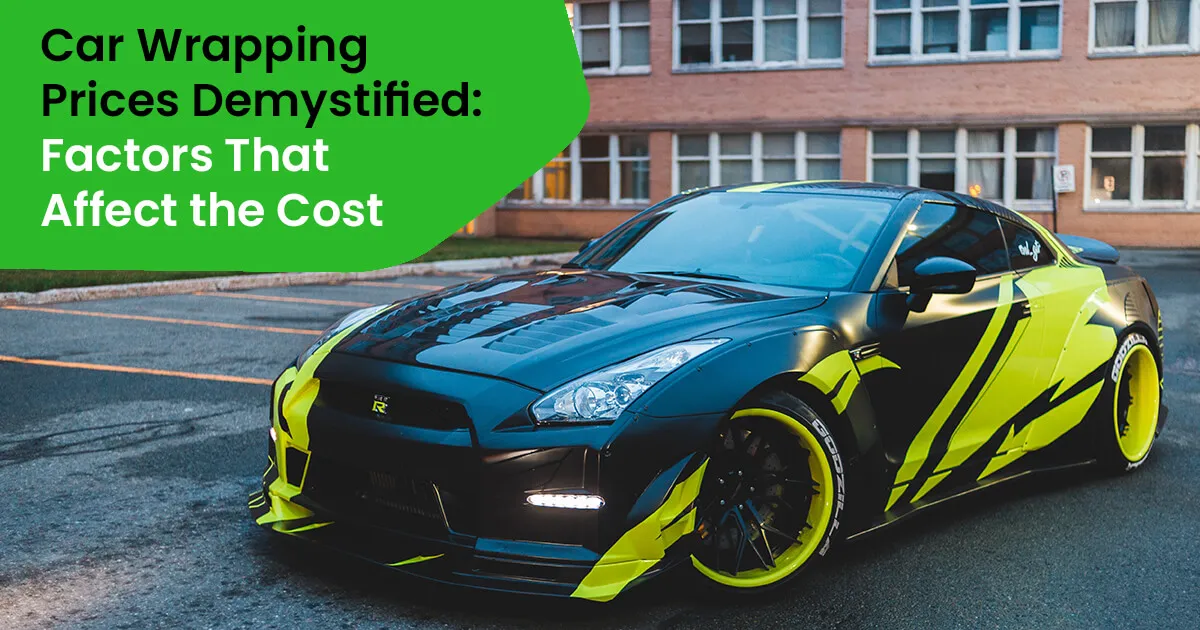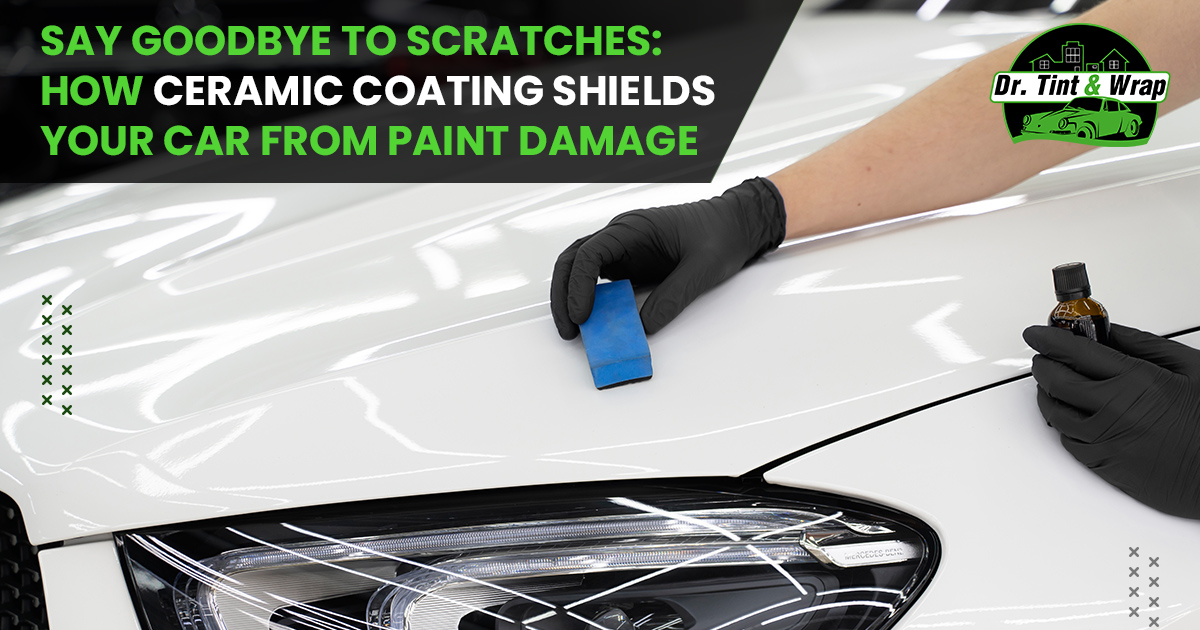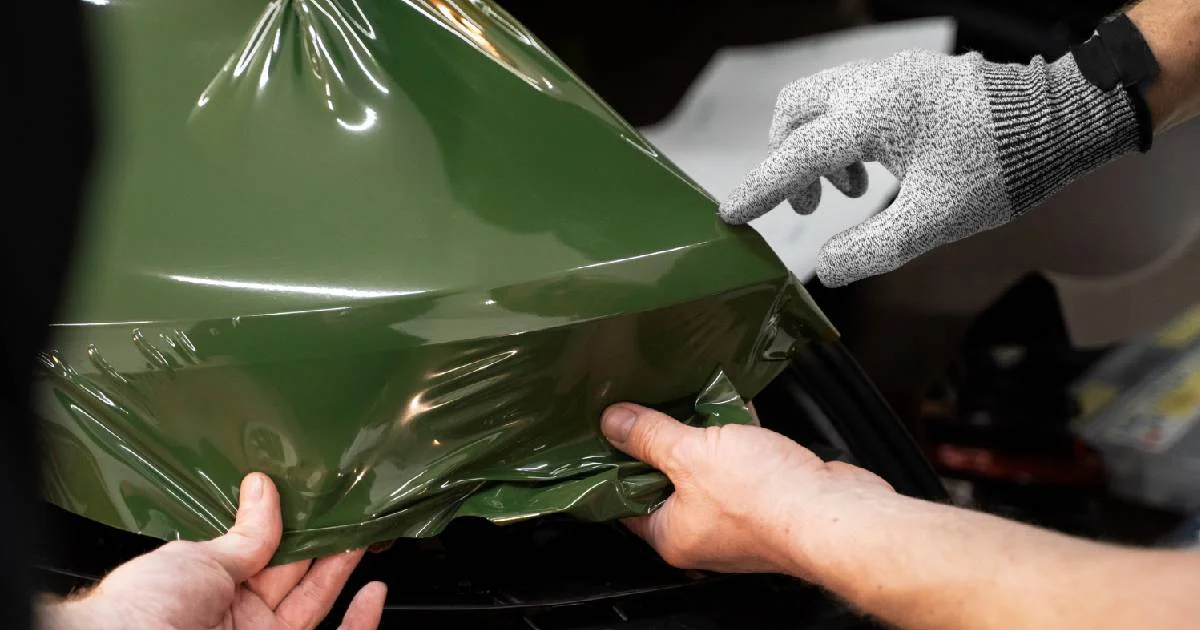
Car Wrapping Prices Demystified: Factors That Affect the Cost
06 Jun 2023, By AdminCar wrapping has become an increasingly popular option for vehicle owners who want to give their cars a unique appearance or protect their original paintwork. However, one common question that arises when considering car wrapping is, "How much does it cost?" Car wrapping prices can vary significantly depending on several factors. In this blog post, we will demystify car wrapping prices and explore the key factors that influence the cost.
1. Type of Wrap Material
The choice of wrap material plays a crucial role in determining the cost of car wrapping. There are various options available in the market, ranging from basic vinyl wraps to premium-grade materials. The quality, durability, and finish of the wrap material directly affect the price. High- quality materials tend to be more expensive, but they offer better longevity and superior aesthetics.
2. Vehicle Size and Complexity
The size and complexity of the vehicle are essential considerations in pricing car wrapping services. Larger vehicles such as trucks, SUVs, or vans require more material and labor, resulting in higher costs compared to smaller cars. Similarly, vehicles with intricate body designs, curves, and contours demand additional time and expertise ensure a seamless installation, which can affect the overall pricing.
3. Partial or Full Wrap
Another factor that impacts car wrapping prices is whether you opt for a partial also known as only roof and bonnet wrap or full wrap. A full wrap covers the entire vehicle, including the roof, hood, trunk, and all the body panels. Partial wraps, on the other hand, cover only specific areas of the car. Naturally, a full wrap requires more material and labor, leading to a higher cost compared to a partial wrap.
4. Custom Design and Graphics
If you desire a customized design or graphics on your car wrap, the cost will be influenced by the complexity and intricacy of the design. Custom artwork, logos, or intricate patterns require specialized skills and precision, which may result in additional charges. The more detailed and elaborate the design, the higher the cost will be.
5. Additional Services
Additional services, such as surface preparation, paint protection, and removal of previous wraps, can also impact the overall car wrapping price. Proper surface preparation, including cleaning, degreasing, and removal of any contaminants, is vital for achieving a smooth and long-lasting finish. Paint protection films or clear coats may be recommended to enhance the durability of the wrap, but they can add to the cost.
6. Geographic Location
Car wrapping prices can also vary based on the geographic location. Costs tend to be higher in urban areas or regions with a higher cost of living. Additionally, market competition and local demand can influence pricing. It is advisable to research multiple providers in your area to get a better understanding of the prevailing rates.
Car wrapping prices can vary significantly depending on various factors such as the type of wrap material, the size and complexity of the vehicle, the extent of coverage, custom design requirements, additional services, and geographic location. It is crucial to consider these factors when estimating the cost of car wrapping. To ensure a successful and satisfactory outcome, it is recommended to consult with professional car wrapping providers who can provide accurate pricing information based on your specific requirements. Dr. Tint stands out as a leading provider of top-notch car and vehicle wrapping services, offering the best quality and competitive prices in Hamilton, Rotorua, and Tauranga. Remember, investing in quality materials and expert installation is key to achieving a stunning and long-lasting car wrap.

Say Goodbye to Scratches: How Ceramic Coating Shields Your Car from Paint Damage
06 Jun 2023, By AdminYour car is not just a means of transportation; it's an investment that deserves the best care and protection. The road can be unforgiving, subjecting your vehicle's paintwork to various potential hazards. From loose gravel to bird droppings, your car's exterior faces numerous threats that can leave unsightly scratches and damage. Enter ceramic coating – the revolutionary solution that is changing the game for car enthusiasts and owners in Hamilton and beyond.
Understanding Ceramic Coating
Ceramic coating is a cutting-edge protective solution designed to shield your car's paint from a range of potential damages. Unlike traditional wax or sealants, the ceramic coating forms a permanent bond with the vehicle's paint, creating an invisible layer of protection that is incredibly durable and resistant to environmental factors.
The Power of Ceramic Coating
1. Scratch Resistance: One of the primary benefits of ceramic coating is its exceptional scratch resistance. The microscopic particles in ceramic coatings create an ultra-hard surface that can withstand minor scratches and swirl marks, keeping your car's paint looking pristine.
2. UV Protection: Hamilton's weather can be unpredictable, with strong UV rays that can fade and damage your car's paint over time. Ceramic coating acts as a barrier against UV rays, preventing paint oxidation and color fading, thus extending the life of your car's finish.
3. Chemical Resistance: Ceramic coating provides a high level of protection against acidic substances like bird droppings, tree sap, and bug splatters. These substances can eat into the clear coat and paint if left untreated, but ceramic coating's chemical resistance prevents this damage.
4. Hydrophobic Properties: The hydrophobic nature of ceramic coatings means that water, dirt, and other contaminants slide off the surface effortlessly. This not only keeps your car cleaner for longer but also makes cleaning a breeze.
5. Gloss and Shine: Ceramic coatings enhance the reflective properties of your car's paint, providing a deep, glossy finish that turns heads wherever you go. Your vehicle will maintain that just-waxed appearance without the need for constant detailing.
Why Hamilton Car Owners Should Opt for Ceramic Coating
Hamilton's diverse climate – from humid summers to chilly winters – poses unique challenges to your car's paintwork. By applying a ceramic coating, you can ensure that your vehicle is well-protected against these challenges. Whether it's road salt during the winter months or the scorching sun in the summer, the ceramic coating acts as a shield against these environmental stressors, helping your car maintain its beauty and value.
Choosing the Right Professionals
While ceramic coating offers remarkable benefits, its application requires expertise and precision. This is where trusted professionals specializing in ceramic coating, like those in Hamilton, come into play. These experts have the knowledge and experience to properly prepare your car's surface, apply the ceramic coating evenly, and ensure its proper curing for optimal results.
Investing in ceramic coating is an investment in the long-term health and appearance of your car's paintwork. By creating a protective barrier against scratches, UV rays, chemicals, and contaminants, ceramic coating ensures that your car remains as stunning as the day you drove it off the lot. Hamilton car owners can confidently embrace the benefits of ceramic coating to enjoy their rides for years to come, knowing that their vehicles are shielded from the elements. Say goodbye to scratches and welcome a new era of paint protection with ceramic coating. Dr. Tint, a trusted name in Hamilton, offers top-notch ceramic coating services that provide long-lasting protection for your vehicle's paint. Their expert team ensures your car remains shielded from scratches, UV rays, and environmental factors, maintaining its pristine appearance.

What is the cost of wrapping a car?
06 Jun 2023, By AdminWhat is the Cost of Wrapping a Car?
Car wrapping has become an increasingly popular way for vehicle owners to change the appearance of their cars without the permanence of a paint job. But what exactly goes into the cost of car wrapping? In this blog, we'll dive into the factors that influence the price of car wrapping, helping you understand what to expect if you decide to give your car a fresh new look.
Understanding Car Wrapping
Car wrapping involves applying a vinyl film over the surface of your vehicle. This process allows for a variety of finishes, including matte, gloss, satin, and even custom designs. Unlike traditional paint, a car wrap can be removed without damaging the original paint, making it a versatile and reversible modification.
Factors Affecting the Cost of Car Wrapping
The cost of car wrapping can vary significantly based on several factors. Here are the key elements that influence the overall price:
- Vehicle Size and Type
The size and type of your vehicle are primary determinants of the wrapping cost. Wrapping a small sedan is generally less expensive than wrapping a larger SUV or a luxury sports car. This is because larger vehicles require more vinyl material and more labor hours to cover all the surfaces properly. - Vinyl Quality and Finish
The quality of the vinyl and the type of finish you choose play a significant role in the cost. High-quality vinyl from reputable brands such as 3M or Avery Dennison can cost more but offers better durability and appearance. The finish also impacts the price; specialty finishes like matte, chrome, or carbon fiber tend to be more expensive than standard gloss or satin finishes. - Design Complexity
If you opt for a custom design or a wrap with intricate patterns and graphics, the cost will increase. Custom designs require additional time for design, printing, and installation. Simple, single-color wraps are typically more affordable. - Installation Labor
Labor costs vary based on the installer’s expertise and location. Professional installers with a proven track record may charge more for their services, but they also ensure a higher-quality finish. In metropolitan areas or places with a high cost of living, labor rates may be higher compared to rural areas. - Surface Preparation
Before applying the vinyl wrap, the car's surface must be thoroughly cleaned and prepped. If your vehicle has scratches, dents, or other imperfections, these need to be addressed, which can add to the overall cost. Some shops include minor prep work in their pricing, while others may charge extra. - Additional Features
Additional features such as wrapping door jambs, interior trims, or wheels can also increase the cost. These are often considered add-ons and are priced separately.
Average Cost Breakdown
To give you a general idea, here’s a rough estimate of car wrapping costs based on vehicle size and type:
- Compact Car (e.g., Honda Civic, Ford Focus): $1,500 - $3,000
- Mid-Size Sedan (e.g., Toyota Camry, BMW 3 Series): $2,000 - $4,000
- SUV/Truck (e.g., Ford Explorer, Chevrolet Tahoe): $3,000 - $5,000
- Luxury/Sports Car (e.g., Porsche 911, Tesla Model S): $4,000 - $10,000
These prices can vary depending on the factors mentioned earlier.
Is Car Wrapping Worth the Cost?
Car wrapping offers several advantages that can justify the cost:
- Customization: You can achieve a unique look that stands out.
- Protection: Vinyl wraps protect the original paint from minor scratches and UV damage.
- Reversibility: If you want to revert to your car's original color or change the design, you can simply remove the wrap.
- Resale Value: Preserving the original paint can help maintain the vehicle’s resale value.
Conclusion
Car wrapping can be a worthwhile investment for those looking to personalize their vehicle or protect its paint. The cost of car wrapping varies based on factors such as vehicle size, vinyl quality, design complexity, labor, surface preparation, and additional features. By understanding these factors, you can make an informed decision and choose a car wrapping service that fits your budget and needs. Whether you’re looking for a bold new look or subtle sophistication, car wrapping offers endless possibilities to transform your vehicle’s appearance.
.webp)
The Future of Car Care in Rotorua: How Ceramic Coating is Revolutionizing Vehicle Protection
06 Jun 2023, By AdminIn the picturesque city of Rotorua, where natural beauty meets modern living, car enthusiasts and everyday drivers alike are experiencing a revolution in vehicle protection. The automotive industry has witnessed significant advancements over the years, and one innovation that has captured the attention of Rotorua's residents is ceramic coating. This cutting-edge technology is transforming the way vehicles are cared for, ensuring they remain in pristine condition even in the harshest of environments. In this article, we delve into the world of ceramic coating in Rotorua and explore how it is shaping the future of car care.
The Essence of Ceramic Coating
Ceramic coating, often referred to as nanocoating, is a protective layer applied to a vehicle's exterior. Unlike traditional wax or sealant, ceramic coatings are infused with nanoparticles that bond with the vehicle's paint, forming a durable and hydrophobic barrier. This barrier offers remarkable protection against environmental contaminants, UV rays, bird droppings, tree sap, and even minor scratches. With Rotorua's diverse climate and the challenges it poses to vehicles, the ceramic coating has emerged as an indispensable solution.
Rotorua's Unique Environment and Car Care Challenges
Rotorua's picturesque landscapes and geothermal wonders attract visitors from around the globe, but its unique environment can be harsh on vehicles. The city experiences everything from intense sunlight and heat to sudden temperature changes and airborne pollutants. Traditional car care methods often fall short in providing comprehensive protection against these challenges. This is where ceramic coating Rotorua comes into play.
Advantages of Ceramic Coating
- Unmatched Protection: Ceramic coatings create a strong shield that prevents dirt, grime, and pollutants from bonding to the vehicle's surface. This ease of cleaning helps maintain the car's appearance and reduces the frequency of washes.
- Enhanced Aesthetics: Rotorua's vehicles can maintain their showroom shine for years with ceramic coatings. The coating's hydrophobic properties cause water to bead up and roll off, taking contaminants with it and leaving the vehicle looking pristine.
- UV Resistance: The harsh New Zealand sun can cause paint fading and oxidation over time. Ceramic coatings offer excellent UV protection, helping the paint retain its vibrancy and preventing long-term damage.
- Chemical Resistance: The geothermal activity in Rotorua can sometimes release chemicals into the air that may harm a vehicle's paint.Ceramic coatings provide an effective barrier against these chemicals, preventing etching or staining.
- Scratch and Swirl Resistance: While ceramic coatings won't make a vehicle completely impervious to scratches, they do offer an added layer of defence against minor abrasions and swirl marks.
The Application Process and Longevity
Ceramic coating application requires precision and expertise. Professional detailers in Rotorua are skilled in preparing the vehicle's surface, applying the coating, and ensuring an even and consistent finish. The process involves meticulous cleaning, polishing, and sometimes paint correction to achieve the best results. When applied correctly, ceramic coatings can last for several years, far outlasting traditional waxes and sealants.
Investing in the Future of Car Care
As Rotorua's automotive scene continues to evolve, so does the approach to car care. Ceramic coating has emerged as a game-changer, offering unparalleled protection against the unique challenges posed by the city's environment. By investing in a ceramic coating for their vehicles, Rotorua's residents are ensuring that their cars not only retain their beauty but also stand the test of time. The future of car care in Rotorua is being reshaped by the transformative power of ceramic coatings. This advanced technology provides a comprehensive solution to the city's diverse environmental challenges, offering unmatched protection, aesthetic enhancement, and long-lasting results. As the automotive industry continues to progress, one thing is clear: the ceramic coating is here to stay, revolutionizing the way we protect and preserve our vehicles in the stunning city of Rotorua. Dr. Tint stands at the forefront of vehicle care in Rotorua, offering state-of-the-art ceramic coating services that provide unrivaled protection and a lasting sheen for vehicles. With a commitment to excellence, Dr. Tint brings the future of car care to Rotorua's residents, ensuring their vehicles stay pristine amidst the city's unique environmental challenges.
